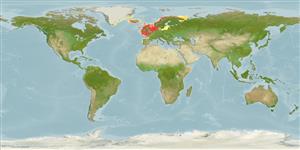Classification / Names
Common names from other countries
Main reference
Size / Weight / Age
Max length : 100.0 cm SL male/unsexed; (Ref. 4705); common length : 40.0 cm TL male/unsexed; (Ref. 3397); max. published weight: 7.0 kg (Ref. 173); max. reported age: 50 years (Ref. 173)
Length at first maturity
Lm 30.8, range 24 - 42 cm
Environment
Marine; brackish; demersal; oceanodromous (Ref. 51243); depth range 0 - 200 m (Ref. 35388), usually 10 - 50 m (Ref. 35388)
Climate / Range
Temperate; 2°C - 15°C (Ref. 5504), preferred 12°C (Ref. 107945); 72°N - 36°N, 54°W - 45°E
Distribution
Northern Sea. Reports from the Mediterranean Sea appear to be misidentifications of
P. flesus. It may have been present in some areas of the Mediterranean in the past, as a result of climatic changes related to the ice age, but at present times seem to be absent (Ref. 89040).
Countries | FAO areas | Ecosystems | Occurrences | Introductions
Short description
Dorsal
spines
(total): 0;
Dorsal
soft rays
(total): 65-79;
Anal
spines: 0;
Anal
soft rays: 48 - 59. Smooth with small scales. Bony ridge behind the eyes. Upper side brown or greenish brown with irregularly distributed bright red or orange spots. The underside is white. Lateral line straight, slightly curved above pectoral fin. Dorsal fin reaching eye. More than 30 vertebrae.
IUCN Red List Status (Ref. 115185)
Threat to humans
Harmless
Human uses
Fisheries: highly commercial; aquaculture: commercial; gamefish: yes; aquarium: public aquariums
Tools
Special reports
Download XML
Internet sources
Estimates of some properties based on models
Phylogenetic diversity index
PD50 = 0.6250 many relatives (e.g. carps) 0.5 - 2.0 few relatives (e.g. lungfishes)
Trophic Level
3.2 ±0.50 se; Based on food items.
Resilience
Medium, minimum population doubling time 1.4 - 4.4 years (K=0.06-0.34; tm=2-6; tmax=30; Fec=50,000)
Vulnerability
High to very high vulnerability (71 of 100)
Price category
